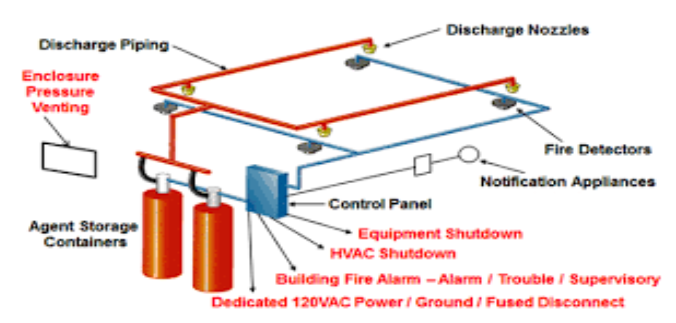Office Suppression
A fire suppression system is an engineered group of units that are built to extinguish fires through the application of a substance. Most commonly, a fire suppression system has built-in components that detect fires at the beginning stages through heat, smoke, and other warning signals.
A fire suppression system is an integral part of any fire protection infrastructure. ‘Fire suppression’ is a collective term for any engineering group of units that are designed to put out a fire. This can be achieved by applying an extinguishing substance such as water, foam or chemical compounds. This article explores the range of applications within a fire suppression strategy, so site teams and building owners can begin to comply with fire safety regulations and give peace of mind to building occupants and tenants alike.
How does a fire suppression system work?
⦁ Detect
Firetrace detects fires at the source using proprietary heat and flame detection tubing.
⦁ Activate
The Firetrace system activates automatically, providing protection even when no one is
around.
⦁ Suppress
Firetrace systems suppress fires in seconds using clean agents that are safe for people,
equipment, and the environment.



A fire suppression system will have built-in components to detect fires as early as possible. These components will first identify the presence of flames and smoke. The suppression system will then initiate an alarm, so the blaze can be subdued before it has the chance to spread. A fire suppression system can be considered an ‘active’ fire protection method because the system is triggered in response to the presence of fire. As will be explored further in this article, a fire suppression system also contains a range of components that ‘actively’ work to extinguish flames and smoke.
Fire suppression systems are used to extinguish, control, or in some cases, entirely prevent fires from spreading or occurring. Fire suppression systems have an incredibly large variety of applications, and as such, there are many different types of suppression systems for different applications being used today. Of these, there are some that are still in use but are no longer legal to manufacture and produce.
What is the difference between a fire sprinkler and a fire suppression system?
Both fire suppression systems and sprinkler systems can control or extinguish fires and are activated when detecting heat or smoke. A fire suppression system, however, doesn’t use water as it can be ineffective in certain types of fires. For example, a facility that uses combustible gas or oil, for instance, would not benefit from using water as a fire suppressing agent. For this reason, fire suppression systems are more common in industrial environments than traditional water sprinkler systems.
When is a fire suppression system required?
Fire suppression systems should be installed in buildings where a sprinkler system may not be the most effective method of fire protection. These can include rooms that contain a large amount of electrical equipment, irreplaceable assets or perishable items that could be susceptible to water damage.
Although there are no legal installation requirements for fire suppression systems, property owners, be they commercial or residential, are responsible for arranging experts to conduct fire risk assessments. This assessment, whether conducted internally or externally, may reveal the need for a fire suppression system. Further information can be found in our article on who exactly is responsible for fire safety legislation.
When identifying the best option for your specific needs, it’s advisable to know how both active and passive fire protection systems work in tandem to extinguish flames. This is vital for risk management, reducing the risk of structural damage as well as safeguarding a building’s occupants.